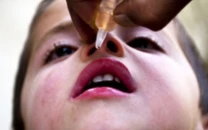Education emergency: No schoolbooks in these hands
For the girl child of Pakistan, there are many blockades on the road to school.

For the
girl child of Pakistan, there are many blockades on the road to school. DESIGN: MAHA HAIDER
They sat on a mound, making dung cakes in Basti Khundo in Rahim Yar Khan (Southern Punjab). Having made palm-sized dung cakes in her 15 years, Aisha was with her little 3 year old sister. Dutifully, she put aside some dung to make some toys for her baby sister.
Aisha does not go to school.
“Aisha helps me look after the house,” says her mother. Aisha feels a strong sense of responsibility towards her parents. “My father goes around all day looking for work. I feel bad asking him to send me to school when I have younger siblings to look after and my mother remains unwell. I wish I could do more,” says Aisha, as she draws a smiley face on a dung cake. Aisha has two younger brothers and her mother is expecting yet another baby.
Why is Aisha out of school?
Aisha is among the 17.6 per cent of Pakistani children, according to UNICEF, who are working and supporting their families. Children working as domestic help is a common phenomenon in Pakistan, and this sector employs more girls than boys.
Fragile and conflict-affected countries account for more than 30 percent of all children not completing primary school globally (source: World Bank). Pakistan fits the bill.
Often, eldest daughters of under-privileged families, like Aisha, take up the role of caretakers of younger siblings, sick parents and grandparents. They are employed as farm help or housemaids. While parents know the importance of education for alleviating poverty, they are compelled to pull out their children from school for economic reasons.
Aside from financial difficulties, causes such as loss of interest and motivation also become reasons for girls not attending school or dropping out in early grades.
Seemingly small things like lack of bathrooms in schools are reason why girls are held back from the same educational opportunities as boys. Studies in many developing countries have shown that provision of separate toilets for boys and girls in schools decreased dropout rates, especially among older girls.
A lack of money for daily transport to school is another reason. In many villages there are no schools to go to after the primary level. While boys can travel to a nearby town, girls cannot and so drop out of school.
“I want to send my children to school. But I cannot afford to pay their fees, buy them books or pencils every month. Mostly people of this village don’t send their children to school,” says Mariana Bibi, a mother from a remote village in Lasbela, Balochistan.
Fewer chances for girls
The Annual Status of Education Report 2012 by the South Asian Forum for Education Development (SAFED) reports that 23 percent of all school aged children, predominantly girls in rural areas, are still out of school, reinforcing the urgency to address the education emergency.
As highlighted by the Global Monitoring Report 2012, Pakistan ranks as the second highest country for out of school children.
More girls are out of school because they are not the future breadwinners and are needed to help their mothers at home. When the mother is out to work or busy suffering health issues due to too many children in quick succession, the girl child takes care of the younger siblings.
The choices made by parents to maximize the returns on the investments of their children can work against girls.
Solutions:
An encouraging 6 million girls in Bangladesh are now attending secondary school because of targeted stipends and incentives (Source: World Bank). Pakistan must follow these models. Where poverty adversely deters schooling, parents, schools and communities can work together to mitigate its effects. Providing transportation services, breakfast programs, book loans, financial aids, and other kinds of services have already been shown to be effective in preventing dropout.
A great deal of counseling is needed for girls and boys in rural areas, combined with sensitisation and rigorous lobbying with parents and community elders. These girls can be the harbingers of hope for their communities.
Published in The Express Tribune, May 14th, 2013.


















COMMENTS
Comments are moderated and generally will be posted if they are on-topic and not abusive.
For more information, please see our Comments FAQ